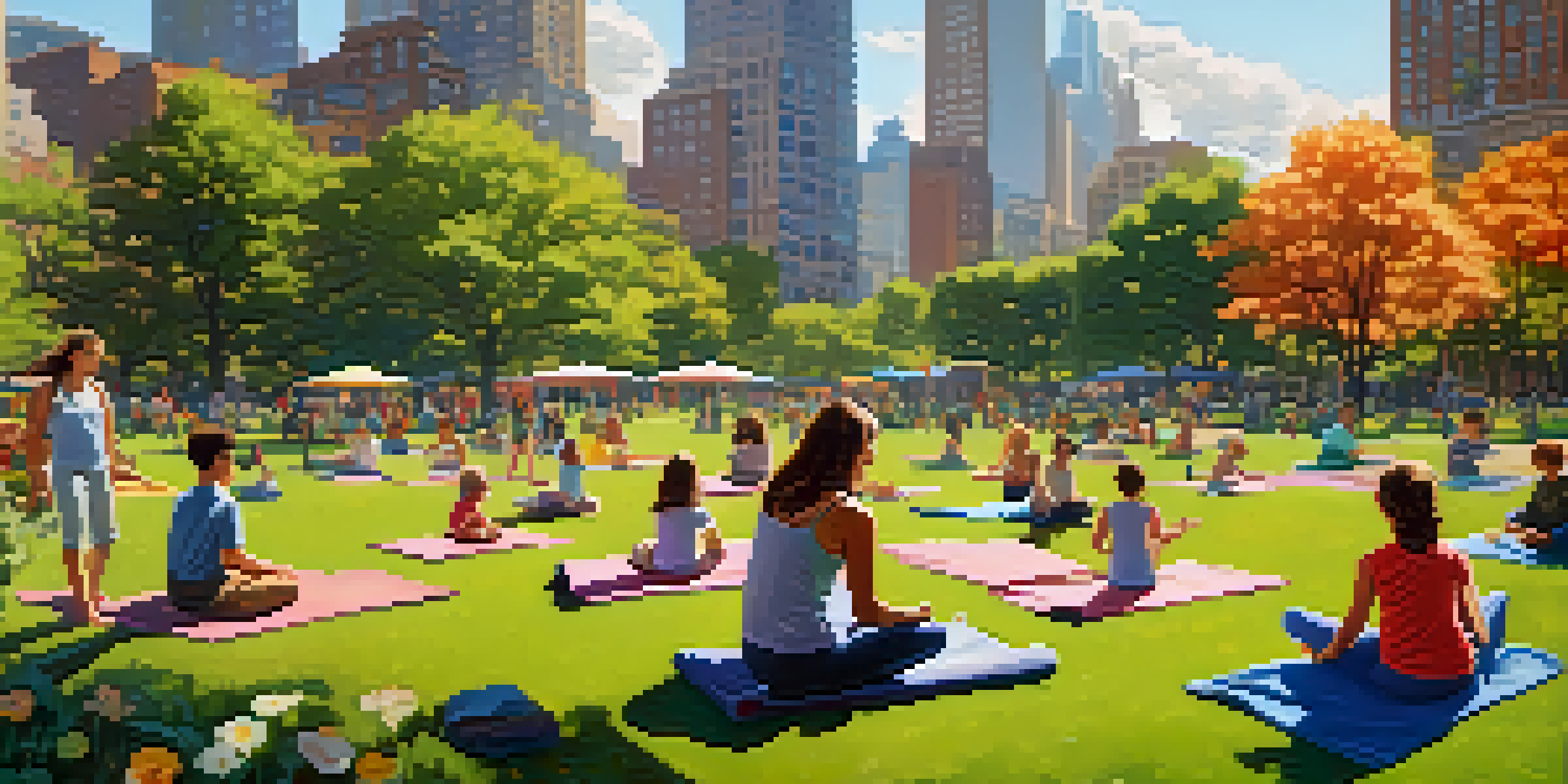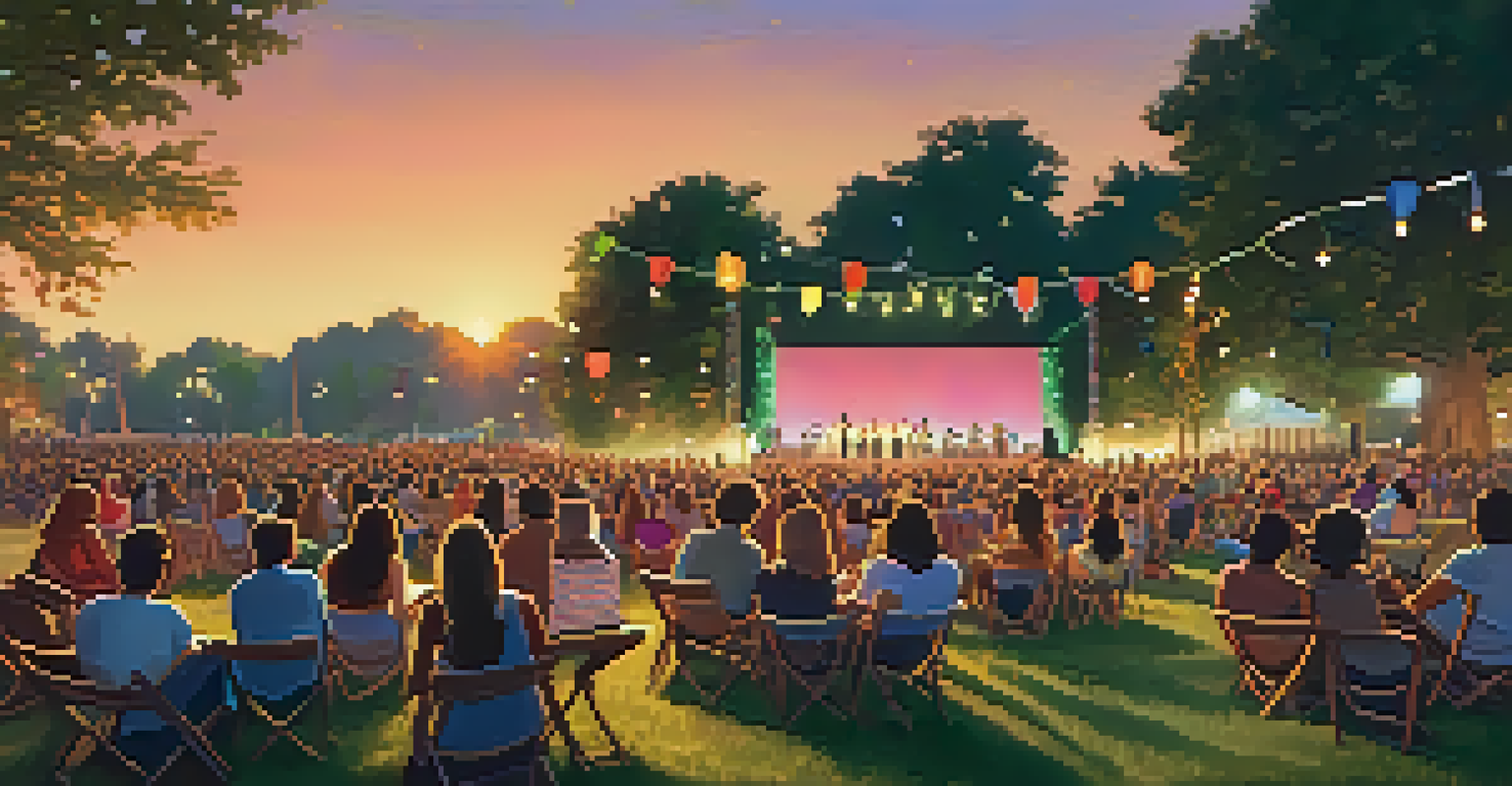The Cultural Impact of Public Parks in American Cities

Public Parks: The Heart of Urban Communities
Public parks serve as vital green spaces in urban areas, often acting as the heart of communities. They provide a place for residents to gather, socialize, and engage in various activities. Whether it's a family picnic or a morning yoga class, parks bring people together, fostering a sense of belonging.
Parks are not just a place to play; they are the heart of a community.
These spaces not only enhance aesthetic appeal but also improve the quality of life for city dwellers. They offer a natural escape from the hustle and bustle of city life, allowing people to unwind and rejuvenate. In essence, parks act as a refuge, where nature meets urban living.
Moreover, public parks are inclusive spaces where individuals from diverse backgrounds can interact. This mingling creates opportunities for cultural exchange, promoting understanding and tolerance within communities.
Historical Significance of Public Parks
The history of public parks in America dates back to the 19th century, with the establishment of iconic spaces like Central Park in New York City. Designed by Frederick Law Olmsted and Calvert Vaux, Central Park aimed to provide city residents access to nature, a revolutionary idea at the time. This vision laid the groundwork for future parks across the nation.

As cities expanded, public parks became essential in urban planning. They were envisioned as places for recreation, health, and community engagement, reflecting the growing recognition of public health in urban environments. This historical significance remains evident as parks continue to evolve in response to changing societal needs.
Parks Enhance Community Connection
Public parks serve as vital gathering spaces that foster social interaction and cultural exchange among urban residents.
Today, many parks commemorate historical events or figures, contributing to a city's cultural narrative. They serve as living museums, reminding citizens of their shared history and the importance of preserving it.
Parks as Cultural Hubs for Events and Activities
Public parks often transform into vibrant cultural hubs, hosting events that celebrate local traditions, music, and art. From summer concerts to food festivals, these spaces provide a platform for communities to showcase their unique cultural identities. These gatherings not only entertain but also strengthen community ties.
The best way to predict the future is to create it, and parks are essential for creating a vibrant urban environment.
For example, summer movie nights in parks allow families to enjoy films under the stars, creating a nostalgic experience that fosters community spirit. Such events encourage participation and engagement, making parks a central part of social life in American cities.
Additionally, parks often feature art installations or sculptures, integrating culture into the environment. This blend of nature and creativity enriches the park experience, inviting visitors to explore and appreciate the artistic expressions unique to their community.
Public Parks and Health Benefits for Urban Residents
Numerous studies have shown that access to public parks can significantly improve the physical and mental health of urban residents. Parks encourage outdoor activities like walking, jogging, and cycling, promoting a healthier lifestyle. These activities not only enhance physical fitness but also foster mental well-being.
Moreover, spending time in nature has been linked to reduced stress and anxiety levels. Public parks provide a serene environment where individuals can escape the pressures of daily life, recharge, and find peace. This connection to nature is particularly vital in fast-paced urban settings.
Health Benefits of Green Spaces
Access to public parks promotes physical and mental well-being by encouraging outdoor activities and providing a serene escape from urban life.
By prioritizing green spaces, cities can promote health equity, ensuring that all community members have access to recreational opportunities. This commitment to public health reflects the growing recognition of parks as essential to overall community well-being.
Environmental Benefits of Urban Parks
Public parks play a crucial role in enhancing urban environments by improving air quality and reducing heat. The trees and vegetation found in parks act as natural air filters, absorbing pollutants and releasing oxygen. This is especially important for densely populated cities, where air quality can be a significant concern.
In addition, parks help mitigate the urban heat island effect, a phenomenon where city areas become significantly warmer than their rural surroundings. By providing shaded areas and promoting biodiversity, parks contribute to cooler urban landscapes, making cities more livable.
Furthermore, parks can aid in stormwater management, reducing flooding risks in urban areas. They allow rainwater to infiltrate the ground, decreasing runoff and promoting healthier ecosystems. These environmental benefits illustrate the importance of preserving and expanding public parks in cities.
Parks as Spaces for Education and Awareness
Public parks often serve as educational platforms, providing opportunities for environmental education and community awareness. Many parks host programs that teach visitors about local ecosystems, conservation efforts, and sustainable practices. This educational aspect fosters a deeper connection between individuals and their environment.
For instance, nature walks led by park rangers or community volunteers can engage visitors of all ages, sparking curiosity about wildlife and plant species. These experiences not only enrich visitors' knowledge but also inspire a sense of stewardship for natural resources.
Parks Support Environmental Health
Public parks improve urban environments by enhancing air quality, reducing heat, and managing stormwater, making cities more livable.
Additionally, parks can host workshops on topics like gardening or recycling, promoting sustainability within the community. By integrating education into the park experience, cities can cultivate a more informed and environmentally conscious population.
Future of Public Parks in Urban Planning
As urban areas continue to grow, the future of public parks is becoming increasingly important in city planning. Municipalities are recognizing the need to prioritize green spaces to enhance livability and foster community engagement. Innovative designs and multifunctional parks are emerging as key components of sustainable urban development.
For example, cities are incorporating features like community gardens, playgrounds, and fitness stations into park designs, creating spaces that cater to diverse needs. This approach encourages greater utilization of parks, making them integral to daily life.

Moreover, as cities face challenges like climate change and population density, public parks will play a vital role in promoting resilience. By integrating green infrastructure, cities can enhance their adaptability, ensuring that parks remain valuable assets for future generations.